Summary of Yoshitomo Nara
Nara is a central figure within contemporary Japanese art. He is associated specifically with the rise of Superflat art; a term coined by Nara's compatriot Takashi Murakami to describe a movement that blends a two-dimensional (flat) graphic design with the more contemplative interests of fine art. Nara's deceptively simple art uses cartoon-like imagery to express conflicting childhood emotions and anxieties within a single figure. His children are typically shown in a mood of resistance and rebellion or, sometimes, in a more tranquil or contemplative state. Given his nationality, and the illustrative quality of his art, Nara has often been associated with the traditions of Japanese manga and anime but Nara's work draws on a much wider range of influences ranging through Western Punk Rock and fairy tales to Eastern religion and philosophy. In the later, more introspective, phase of his career, Nara has turned his attentions to sculpture and installation art, but it is through his enduring "Romana" portraits that he remains most readily associated.
Accomplishments
- Superflat art is now considered a staple of postmodern art. It is based on Japan's post World War II obsession with anime and manga comic books but Nara's more outward looking worldview has done much to promote the reputation of the so-called Japanese "Pop art" in mainstream Western culture.
- Many of Nara's works are inspired by Punk music and the ethos of rebellion and defiance. His work takes the traditional Japanese theater character of Otafuku, a figure who represents joy and who is always depicted with full cheeks and cheerful eyes, and turns her into a mischievous, brooding "punk" child. These works have even helped overturn the perception of Japan as an inflexible society governed by ancient social conventions.
- Nara's cartoon-based approached has sometimes been compared to the work of Keith Haring. However, Nara's figures are more archetypal and play around much more with the Japanese tradition of the kawaii: the idea that we might feel empathy with feeble and helpless creatures. Like Haring, however, his work has managed to captivate at once the imagination of serious art collectors and critics, and the rebellious youth who consume his art through numerous items of mass reproduction.
- Nara's work often incorporates words or short phrases. In an attempt to reduce his art to a single, simple, idea or concept, his use of words are intended to overcome any ambiguities in the artist's intentions and to enable his viewer to identify specifically with Nara's point of view. In a postmodern context where artists usually prefer meaning to remain ambiguous, Nara offered a more reductive way of looking at his art.
- As a direct result of the fallout from the Fukushima earthquake and the death of his father, Nara's mature works took on a more existential focus. The artist becomes more introspective and philosophical, encouraging, through his art, his audience to come to a higher level of consciousness. In his Midnight series, for instance, Nara brought a Buddhist sensibility to his work that invited comparisons with the transcendental aims of Mark Rothko.
The Life of Yoshitomo Nara
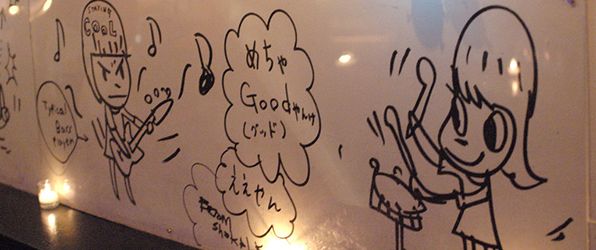
Nara blends imagery and ideas from the Japanese and American popular culture that he adored as a boy, creating cartoonish, but not always so innocent, images of children, many of whom express the same sense of angst and/or loneliness that he felt in periods of his own life.
Important Art by Yoshitomo Nara
The Girl with the Knife in Her Hand
This early work is emblematic of Nara's signature style: flat, two-dimensional, rosy-cheeked and wide-eyed children placed against empty or nondescript backgrounds. The removal of these archetypal figures - often referred to in Japan as kawaii - from recognizable settings lends them a universal appeal that transcends the limits of time and place. Indeed, the writer Banana Yoshimoto has suggested that Nara's "work attracts many people, because they recognize their precious inner solitude within [the artwork]".
The artist himself cites the children's picture books he grew up with (the likes of Hans Christian Andersen, the Brothers Grimm, and Aesop) as his main influence, observing that "They all reflect our darker side". Indeed, many of Nara's childhood characters express an aggressive or rebellious side; either brandishing weapons (a knife in this case) or smoking cigarettes. Yet Nara insists that his armed children do not pose any realistic threat: "Look at them, [the weapons] are so small, like toys. Do you think they could fight with those? I don't think so. Rather, I kind of see the children among other, bigger, bad people all around them, who are holding bigger knives".
The anthropologist Marilyn Ivy explains that "The origins of kawaii had to do with pity or empathy for a small or helpless creature - archetypically, a child or infant. There is always a dimension of vulnerability, smallness, and - indeed - (feminized) childishness attending the kawaii". Although Western viewers tend to perceive Nara's kawaii characters to be girls (a view backed up here by the title of the painting) the artist himself asserts that his figures are essentially non-gendered: "For me, there is no distinct sex because people become men or women when they grow up. Children are more neutral. That is the way I see them".
Acrylic on cotton - Private Collection
Untitled (Nobody's Fool)
The title "Nobody's Fool" was given to Nara's first major New York exhibition, presented through the Asia Society, in 2010, and was borrowed from 1973 album by the Memphis-based musician Dan Penn. The title pays direct homage to Penn's reputation for "individualism" but it was only one of many of the collections' musical allusions to rebellious rock and punk music (by the likes of Neil Young, the Ramones, and Green Day).
Untitled (Nobody's Fool) presents a young girl with an angry and defiant "punk" expression while at the same time adopting the formal attributes of Ukiyo-e woodblock prints such as those made by Kitagawe Utamaro (1753-1806). The work follows the precise composition - hairstyle, hand positioning, scratched background - of Utamaro's female book reader in Kobikicho Arayashiki Koiseya Ochie. The academic Max Weintraub described how "Utamaro's period prints were mass-produced commercial artifacts that not only proved popular in Japan, but also circulated widely throughout Europe in the latter half of the 19th century during a particularly intense period time of the West's fascination with and appropriation of Japanese visual culture". Weintraub observed, moreover, that Untitled (Nobody's Fool) "contains a number of clichés both past and present, including that of a Japanese girl with a chopstick bun hair style and the phrase "No Nukes" written on her headband. These clichés seem to level any distinction between conventions of the distant past and those of the 1960s and 70s, and [self-consciously] complicate the ideal of authenticity and individuality" in Nara's art.
Acrylic, ink, colored pencil and graphite on printed paper - Private Collection
Knife Behind Back
In this monumentally large painting we see a recurrent Nara character named Ramona - after the American punk band Ramones - a young girl with a bob haircut, wearing a red dress with a white collar. Here, she frowns and glares defiantly at the viewer. Her right arm is hidden behind her body, and it is only from the title of the work that we come to learn that she is brandishing a knife.
According to the description in the Sotheby's catalogue, by concealing the knife its threat becomes "infinitely more ominous [and] underscores the unexpected insurgent power of children and the associated radical potentiality of the insignificant, the innocent, the fictionary, and the imagined [and was the] driving force behind Nara's epochal iconography of sullen, disgruntled, yet endearing and captivating youth". The work was created at a time when Nara was reinventing his personal style; moving away from the thick, black, neo-expressionist outlines and vibrant colors he used during the 1990s, toward a softer palette and more painterly quality. Anime and manga illustrator and art critic Midori Matsui (cited through Sotheby's) noted that at this stage in his career Nara's characters began to display "visible signs of humanization" in the way their "heads grew smaller, their expressions gentler, their body proportions approaching that of a real child, and their attitudes reflecting that of a thoughtful adolescent".
In 2019, this painting set the record for the most expensive work ever sold at auction in Japan (the same year, incidentally, a similar national record was set in the United States by fellow Neo-Pop artist Jeff Koons with his 1986 "balloon sculpture" Rabbit). Sotheby's was in no doubt about the painting's value, describing it as "a classic archetype of the artist's strategy that draws on Modernism's sign-like shorthand language of images to leave endless space for resonance and fantasy for both the child and adult viewer". Sotheby's concluded that the work represented the "saccharine sweetness of Nara's figurative lexicon [that] enacts a language undeniably redolent of Pop, anime, cartoon, and manga - one whose extraordinary emotive power endorses "the paradoxical strength of 'minor art', including 'kitsch' imagery's ability to express the emotions of contemporary people".
Acrylic on canvas - Private Collection
Star Island
This editioned print features some of Nara's most popular motifs - the heads of three girls, a dog, and several stars - set against a blank turquoise background. As in all of his works, the cartoon quality makes his figures appear deceptively child-like. However, the complex emotions that can be read into the human figures, as well as the symbolism carried within the other elements, indicate a more profound set of meanings focused around the ideas of youth, rebellion, and the navigation of identity in contemporary society.
For Nara, the submissive obedience of dogs suggests the behavior expected of children. In his art, children and dogs are used as interchangeable symbols of loneliness, fragility, and innocence. Figures with closed eyes became a feature of the artist's more introspective mature period, and in Star Island, we see the dog and one of the girls have their eyes closed. Meanwhile, the four-pointed stars amount to much more than mere decoration. One can see direct similarities here in fact with the work of Murakami for whom stars - which Murakami described as "not just beautiful [but] like the trees in the forest, alive and breathing" - would become something of a motif. For Nara, rather, the stars allude to a range of common childhood tropes, such as receiving a gold star in school (for a well-done assignment), or optimistic encouragements like "shoot for the stars" and "wish upon a star". The range of facial expressions in the characters represented alongside the stars hints at the range of responses that these meanings elicit, and the painting as a whole can be read thus as either one of hope or cynicism.
Color screen-print on woven paper

A to Z Memorial Dog
Alongside "Ramona", Nara's "White Dog" images have become the artist's most iconic. The benign creature has been reproduced as fine art collectables, on T-shirts, as stuffed toys, as moulded transistor radios and through numerous novelty items and trinkets. Here the White Dog takes the form of a giant sculpture; its tightly closed eyes and its rehearsed pose hinting strongly at the theme of Buddhist meditation. The gloss-white color, meanwhile, carries strong associations with the "white-ghost" spirit in Japanese culture. The Memorial Dog (and others produced on a similar scale) also recalls komainu, the mythical lion-like statue that is often used as a symbolic guardian at the entrance to holy shrines and temples (indeed, his "Aomori Dog" is a two story high sculpture that "guards" the entrance to Japan's Aomori Museum of Art).
The sculpture offers a child's unique perspective in terms of scale and feeling, with the animal looming larger than life. However, the overall effect is somewhat melancholic in the way it connotes the theme of self-isolation and loneliness; feelings recalled by Nara in discussions of his own childhood. Indeed, his White Dog represents something of a retreat from reality into the inner world. Speaking of his insular working practice, Nara stated: "I always keep my studio the same. No matter whether I am in Germany or in Nasu, where my current studio is located, my studio's interior settings are always arranged in the same way - so I only find out where I am [in the world] when I open the curtain".
In 2008, Nara, in an attempt to produce a picture book like the ones that offered his comfort in his own childhood, produced The Lonesome Puppy: the story of a supersize dog who finds a lifelong companion in a little girl (the reader may identify thus with the dog or the little girl). Though a children's book, it is an authored work in the way it addresses the fluctuating emotions - sadness, loneliness, belonging, happiness - experienced in the artist's own childhood. The book, like his White Dog sculptures, also functions as reminder to adults of what it is to view the world from a child's perspective.
Fiberglass - Yoshino-cho Park in Hirosaki, Japan
Fire
In Fire, a young girl peers over what appears to be a table at a small (toy?) house in flames with smoke billowing skyward. The formal simplicity of the work encourages the viewer to focus their attention on the child's state of mind. Layers of emotion can be read into the figure's large, almond-shaped eyes, which dance with the reflected color of the flame. Her fascination with the burning building are quite evident. However, her eyes also hint at a sense of mischief; indeed, we may reasonably conclude that the girl (Ramona) is the "arsonist".
In 2013 Nara stated "I used to draw [eyes] too carelessly. Say, to express the anger, I just drew some triangular eyes. I drew obviously-angry eyes, projected my anger there, and somehow released my pent-up emotions. About ten years ago, however, I became more interested in expressing complex feelings in a more complex way".
Anthropologist Marilyn Ivy notes, by way of a comparison with Nara's contemporary, Takashi Murakami, that it is through the child's gaze that Nara truly differentiates his work from that of the more "promiscuous" Superflat artists. For Ivy, there is a "horrific dimension of Murakami's serially repetitive eyes - in the register of loss, figured by the vulnerable yet aggressive children in his work" and that Nara "locates a range of affects that Murakami does not provide". She concludes that Nara's work "embodies a different relationship to the child and to the gaze" and that with his figures "we don't feel so much the pulling of the gaze over the plane of the work [...] as the pulling of our gaze toward the eyes of Nara's children".
Acrylic on wood panel - Private Collection
Midnight Surprise
Nara's early work represents the epitome of Japanese Pop Art. Indeed, like his American predecessors, he has emerged as a celebrity artist who is respected equally in the commercial and critical spheres of the contemporary art world. His work lends itself to the Pop ideals of mass reproduction and his Punk inspired art attracts a strong youth following seduced by the ideas of subversion and rebellion. In keeping with this "Punk" attitude, Nara said of his earlier approach to painting that he would "have an image that I wanted to create, and I would just do it. I would just get it finished". But the "post Fukushima" Nara talks now of "having a conversation" with himself in which he has begun to contemplate Buddhist concerns about solitude and mortality.
In his updated "Ramona" figures the heavy black outlines have given way to what Nara refers to as his blended "color paintings". This spiritual and philosophical transformation even evokes the iconic works of Mark Rothko (which were also spiritual in their conception). Welcoming the comparison with Rothko, Nara said, "it's not about it being an image of a young girl, it's about the many levels of paint that have built up. Those layers draw out the sensibility of each person who looks at it. I think it provokes you to have a conversation with yourself". In a marked shift from his earlier Romonas, Nara's Midnight series reflected a palpable Buddhist worldview: "It's not really my role to educate people", Nara said of this work, but "if a person has the sensibility, or the understanding, or even just has the potential for that understanding, I think that this will allow them to really come in deeper into my world and really understand more [about themselves]".
Acrylic on canvas
Biography of Yoshitomo Nara
Childhood
The youngest of three boys, Yoshitomo Nara grew up in a rural community near the city of Hirosaki, in the northern Japanese prefecture of Aomori. His father and grandfather were both Shinto priests, and later in his career, Nara would draw inspiration of his own from the spiritual teachings of Shinto.
Although he has fond memories of his early childhood, Nara's life copied that of an only child. His parents worked busy schedules while his brothers were some ten years his senior. He was a sensitive boy, and grappled with difficult emotions, recalling: "I was lonely, and music and animals were a comfort. I could communicate better with animals, without words, than communicating verbally with humans". (He recalls that on one occasion he became upset with a group of local boys who set out to destroy an anthill and refused to join them.) Young Nara immersed himself in both Japanese and American pop culture; the latter flooding into Japan after the Second World War. Nara took inspiration from various sources including picture books (his favorite was The Little House by American author Virginia Lee Burton) and fairy tales, American comic books, Disney and Warner Brothers cartoons (especially Astro Boy, Gigantor, and Speed Racer) and rock and punk music.
Nara purchased records by mail, sharing the cost with friends. At the age of sixteen he opened up a cafe with a friend in his hometown, and worked as the DJ there. He was inspired, not only by the rebellious ethos communicated through punk music, but also by the visual culture of music. He explains that "There was no museum where I grew up so my exposure to art came from the album covers".
Nara began to create at a young age, first by sculpting forms out of clay (or even his own excrement) and then by experimenting with drawing. He remembers his first drawing vividly: "It was before nursery school. I drew on a blank page of a book that belonged to my father [...] It was a picture of a curtained window looking out onto a landscape, drawn in red pencil. There was something very abstract about it. I think I drew pretty well as a child". In his teen years, he recalls being eager to paint a live nude model (and at being disappointed when that chance finally came and the model was an elderly woman).
Education and Early Training

Nara had originally planned to study literature, but after a friend praised one of his artworks, he decided to pursue a possible career as a painter instead. With the financial backing of his parents, Nara moved far away from his hometown to Nagakute to study at the Aichi Prefectural University of Fine Arts and Music, earning his Bachelor of Fine Arts in 1985, and his master of fine arts two years later.

Between 1988 and 1993 Nara lived in Germany where he undertook a six-year apprenticeship at the Kunstakademie Düsseldorf (aka: The German State Academy of Arts) under the mentorship of German painter A.R. Penck. During this time he developed a keen interest in Neo-Expressionism and Punk music, while outside of his studies, he earned a living teaching art to high school students.
Nara adopted (as evident in early works such as Flaming Head (1989)) many of the emotionally-charged visual idioms of German Neo-Expressionism, such as the rough, expressive, even aggressive, brushstrokes and bold colors associated with the likes of Markus Lüpertz and Georg Baselitz. Nara took from Penck the use of heavy black outlines as seen, for instance, in his The Girl with the Knife in Her Hand (1991). Nara recalled of his time in Düsseldorf: "I became literally 'alone' there. It strongly reminded me of the memory of my lonely childhood. I felt the city's cold and darkness, just like my hometown, and the atmosphere there reinforced my tendency to seclude myself from the outer world".
Even after the successful completion of his training, Nara felt unsure about the value of a career in art. He said, "All through university I was never sure that I wanted to be an artist by profession [...] I went to art school because I could draw. It was [only] when I was teaching art ... and I was telling all the students that 'this is how artists should be,' and so on [that] it occurred to me that one could draw as a way of finding oneself". It was this moment of self-realization that saw Nara commit to a career in art. Thus, in 1993, and still with only limited grasp of the German language, Nara moved to Köln (Cologne) where he set up a studio. He recalls feeling "very much isolated" but that that feeling of isolation helped him to evolve as an artist: "To be an artist, one might need to be deprived a bit of what he or she has taken for granted: accessibility to things and people, including language and a means of communication [...] I needed a setting which would allow me to isolate myself from others to have a real conversation with the inner-me [...] I found my style only after living in solitude". It was in Köln that Nara received his first meaningful exposure after drawing promotional posters for the Swedish family film Lotta Leaves Home (1993).
Mature Period
A series of collaborative projects in the late 1990s - including a book project with Japanese cult novelist Banana Yoshimoto, as well as commissions to design a CD jacket for Japanese punk band The Star Club, and for Japanese girl band Shonen Knife - propelled Nara into the public eye. He continued teaching during this period, however, working as a visiting professor at the University of California at Los Angeles in 1998. In 2000, Nara finally returned to Japan and worked to cement his career as a painter. He took over a two-story Tokyo warehouse. With its high ceilings and open layout, the warehouse doubled as a studio space and living space. Nara rarely cooked for himself, however, and dined most days at fast-food restaurants.
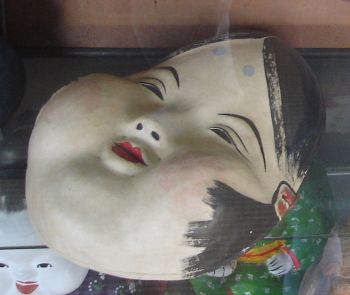
In 2001, Nara became associated with the Superflat movement, which included artists like Takashi Murakami and Chiho Aoshima. Superflat (sometimes referred to as "Japanese Pop Art") was a term coined by Murakami to describe a style of postmodern Japanese art that demonstrates a critical and ambivalent attitude toward pop culture and consumerism. In his personal Superflat style, Nara drew inspiration from traditional Japanese Otafuku and Okame theatrical masks, and Edo period ukiyo-e woodblock prints. The painterly quality and free-form, hand-drawn lines that characterize Nara's oeuvre also contrast sharply with the more "digital" aesthetic of Murakami's work.
Late Period
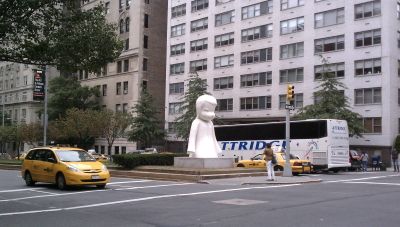
Nara notes that, "Up until [my twenties], I was really only focused on stuff I liked and was interested in. Then, entering into my thirties and forties, and becoming more of an adult, I started seeing more of the world and even seeing things that I didn't want to see. My perspective really opened up. Whether it was to do with society or the environment or the relationship between the two, my view of the world became much wider".
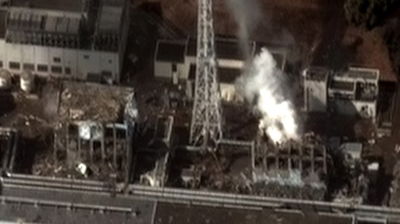
In 2009, Nara was celebrating the completion of a gallery show in New York in an East Village Punk bar called Niagara. Flushed with alcoholic inspiration, Nara drew a number of his signature punk figures directly onto the bar walls. Once finished (and before being arrested for drawing on a subway wall on his way home) he signed and dated his handiwork. While Nara's subway graffiti was quickly removed, his "dive bar mural" was preserved (behind a plastic screen) by the bar owners. The fact that the mural exists as a public artwork saw Nara connected with Keith Haring and Jean-Michel Basquiat both of whom produced works on buildings in the same East Village neighbourhood.
The devastating Fukushima earthquake and tsunami of 2011, which directly affected the Aomori prefecture where Nara grew up, had a profound impact on the artist. As he recalled, "I became unable to draw [...] I was so depressed that I couldn't help feeling that what I'd been doing was totally meaningless and useless. No one needs art in an extreme situation, after all". Eventually, however, he saw people who had been displaced from their homes by the disaster beginning to return and rebuild their lives and it was this that inspired him to return to his own creative activities. As part of this process, he paid several visits to the devastated area before taking up a residency at his alma mater, the Aichi Prefectural University of Fine Arts and Music.
In 2013, Nara's career took a change of direction. As he recalled, "I felt uncomfortable with being given a certain label, whether it was positive or negative. And I remembered that I'd long forgotten how I had started my career. I realised that I'd long neglected the 'conversation with myself', which had been the foundation of my creative activity. So I quit collaboration works and started working with ceramics to restart the conversation". Around the same time, Nara's father passed away, which further contributed to his new-found sensibility: "In the past I would have an image that I wanted to create, and I would just do it. I would just get it finished. Now I take my time and work slowly and build up all these layers to find the best way. Just like you cook so that you know it's going to be the most delicious, you find a way to make your art the best it can be".
Since 2014, Nara has taken an interest in exploring his own roots, turning to photography to document his journey. For instance, he visited the abandoned mines, worked by his grandfather, on the Russian island of Sakhalin (formerly part of Japan). He remarks that, "Standing in front of these ruins, I really felt that I had made my artworks over all these years just to have this experience to find myself in front of this landscape [...] What I saw was neither Japan nor Russia; it was a place that is still in between. In fact, I am very interested today in places that are not one thing or another, that are between two things. So art for me was a big detour that finally allowed me to find what I was really looking for, what I really wanted to do. And when I met the local indigenous peoples, I really had the impression of meeting myself". More recently, and in homage to Takeshi Motai, a Japanese Showa-era picture book illustrator, Nara organized the 2017 exhibition "Takeshi Motai: The Dream Traveler" at the Chihiro Art Museum. It was Nara's way of acknowledging Motai as a significant influence in his own work: "Residing in day-to-day life, Takeshi Motai's aesthetic sense is paradoxically sublime. His artwork makes no distinctions between East and West; it is pure spirit" he said.
Nara currently operates out of two studios; in Germany and Japan. He likes to play "deafeningly loud" music including the Canadian rocker Neil Young, because Young "has a spirit of equality and freedom, bravely singing his songs that make us think what's around us". Nara has always kept to himself, and tries to avoid in-person interviews. He has stated "I'm not a teamwork type of person. I have no 'real or personal life' outside of my working life, like other people may have. Or at least, I'm not good at 'enjoying my life' after I've finished the work". He also avoids social media, as he sees it as a distraction to his artistic pursuits. He recently stated "I'm not really interested anymore in doing big things for mass media attention, but what interests me the most today is entertaining people from small communities with my work", adding that, "Whether I like it or not, the things I make are no longer self-portraits, but belong to the audience who find themselves, their friends or children they know in my paintings. My hope is that they will remain in the history of art [...] that they will survive as long as humankind exists even if my physical body is destroyed".
The Legacy of Yoshitomo Nara
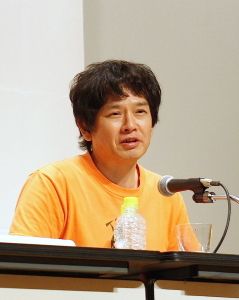
Through his associations with Takashi Murakami and the Superflat label, Nara has helped give Japanese cultural identity a significant voice in the world of Western art markets and Western consumer culture more generally; his art caters simultaneously for the tastes of East and Western audiences, be they child, adolescent, or adult. Nara's significant cult following, which is especially strong throughout Japan and Asia, can be attributed as much to the artist's willingness to fully embrace blogging and Tweeting, and the appearance of his signature characters on any number of consumer durables (ranging from T-shirts and key chains to stuffed toys and ashtrays), as to his original gallery pieces.
With a penchant for simple lines, primary colors, and blank backgrounds, Nara's unmistakable cartoon "portraits" of small children and animals have left many critics struggling to pinpoint the essential value of his art. However, the anthropologist Marilyn Ivy has observed that Nara's art brings about "some sort of cathartic encounter with childhood in viewing his works [and he] has animated fan solidarities around a paradoxically activist art centered on cuteness and its latent capacities to signal a shared realization of the vulnerabilities of young subjecthood in commodity culture". Nara's work is deceptively disarming in the way it reaches beyond the Japanese traditions of anime/manga to embrace universal themes such as isolation, anxiety, rebellion and, in his later works, spirituality. His standing is such that he can now make valid claims to be the most important "cross-over" artist since Keith Haring, while his highly synthetic art, which so effortlessly blends the worlds of high art with kitsch, has seen him placed in the esteemed company of Jeff Koons.
Influences and Connections

-
![Georg Baselitz]() Georg Baselitz
Georg Baselitz ![Markus Lupertz]() Markus Lupertz
Markus Lupertz- Takeshi Motai
- Utamaro Kitagawa
- Chiho Aoshima
-
![Takashi Murakami]() Takashi Murakami
Takashi Murakami ![A.R. Penck]() A.R. Penck
A.R. Penck- Banana Yoshimoto
- Hiroshi Sugito
- Barry McGee
- Ronald Venture
-
![Takashi Murakami]() Takashi Murakami
Takashi Murakami ![A.R. Penck]() A.R. Penck
A.R. Penck- Banana Yoshimoto
-
![Superflat]() Superflat
Superflat ![Neo Pop Art]() Neo Pop Art
Neo Pop Art
Useful Resources on Yoshitomo Nara
- Yoshitomo NaraOur PickBy Yeewan Koon
- Birth and Present: A Studio Portait of Yoshitomo NaraBy Kyoko Wada
- Yoshitomo NaraBy Mika Yoshitake
- Yoshitomo Nara: Nobody's FoolOur PickBy Melissa Chiu and Miwako Tezuka
- Yoshitomo Nara: Drawings: 1984-2013Our PickBy Masue Kato
- Yoshitomo Nara & YNG: The Crated Rooms in IcelandOur PickBy Markús Andrésson, Gumundur Magnússon, Hafthór Yngvason, and Jón Proppé
- Yoshitomo Nara: Lullaby SupermarketOur PickBy Stephan Trescher and Banana Yoshimoto
- Nara Yoshitomo: I Don't Mind If You Forget MeOur PickBy Taro Amano
- Yoshitomo Nara: Nothing Ever HappensOur PickBy Kristin Chambers and Larry Gilman
- The Snow Yak ShowBy Mark Ryden
 Ask The Art Story AI
Ask The Art Story AI


















